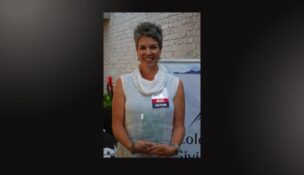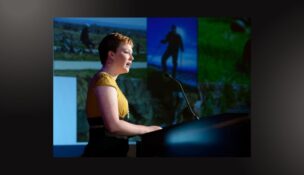

New media on the move
Higher ed stepping up offerings in social media
Mike Dano //March 23, 2015//

"You can still dunk in the dark.”
For those who don’t readily recall this game-changing tagline:
Third quarter.
Super Bowl XLVII.
Power outage.
Lights out for 34 minutes.
But the social media team on hand – including copywriters, a strategist and artists ready to pounce – behind that beloved American cookie brand, Oreo, seized the moment to reach out to an already captive audience. And so they tweeted, “Power out? No problem,” with a modest image of a single Oreo and the caption: “You can still dunk in the dark.” More than 15,000 retweets later and 20,000 likes on Facebook, the spontaneous ad spot was the real winner of
the night.
“The new-world order of communications today incorporates the whole of the way people are interacting with brands right now,” said Sarah Hofstetter, president of digital marketing agency 360i, which handled game-day tweeting for Oreo, in a 2013 Wired magazine interview.
Social Schooling
Two years later, the business world and academia are jumping on board and online.
“It’s Not Just for Fun: You Can Now Major in Social Media,” proclaimed one headline. “College Students to Tweet Even More in Class as Social Media Becomes a Major,” read another.
The institution stirring all the interest was Newberry College in Newberry, S.C., which in 2012 became one of the first colleges in the nation to offer both a major and minor in social media. Not surprisingly, the news generated plenty of caustic commentary on college students gaining credit for frittering away their education on Facebook, Twitter and other networking platforms.
“I felt there was a real need for this,” said Tania Sosiak, associate professor of graphic design and social media at Newberry. She said Newberry currently counts around two dozen students either majoring or minoring in social media, and the college expects that number to eventually level off at around 40.
But why did Newberry offer a social media major in the first place, opening itself to such criticism? “Social media now really incorporates every industry. No industry is really free of that. It’s everywhere,” Sosiak said, noting that she doesn’t teach how to post to Facebook but instead how to use it to reach a goal. “They all know how to use social media,” Sosiak said of her students, “but they don’t know how to use it to develop a brand or promote something. Just because you own a hammer doesn’t mean you’re a carpenter.”
In 2012, a social media major in South Carolina made national headlines. Today specialized certificates, courses and degrees are so common that some colleges in Colorado are doubling down on their socially savvy staffs.
LOCAL LEVERAGING
Amy Hasinoff, an assistant professor in the communications department at the University of Colorado-Denver, was hired shortly after she got her doctorate in 2013 to teach a CU Denver class on new media. “I never had a chance to take a class on new media,” because there were none offered, she said, explaining that her degree was in communications but her dissertation was on new media. She also recently wrote a book on sexting.
Hasinoff said her class at CU Denver doesn’t demonstrate how to post to social media, but rather how to analyze and understand the data. “Everyone is on the Internet, so what does that mean for society?” she asked. “New media is so vital and ubiquitous, we need to understand it and understand how we think about it.”
Hasinoff said 20 to 30 students take her new media class—but that’s just the start. “The department is trying to add more,” Hasinoff said, explaining that her class concentrates on theory, and the university wants to develop classes that focus on applying social media techniques.
MASS COMMUNICATION, MASS APPEAL
Social media “is not valuable to teach, it’s essential to teach,” said Kirk Hallahan, a professor in Colorado State University’s Journalism and Technical Communication school. And, Hallahan added, social media is simply the latest communications technology that colleges and universities have focused on. He said CSU covered Netscape and Web design in the 1980s, and followed that with computer communications, visual design and more recently, Photoshop. “We’ve recognized this for a long time,” he said.
Hallahan said CSU has offered a Digital Promotion Management course since 2008 that covers YouTube, blogging and other topics. He said this year the university is splitting off a new course called Social Media Management that will cover micro-blogging, social networking, social bookmarking, collaboration and other topics.
“We’re seeing social media being used across all the disciplines we teach,” Hallahan said, explaining communications professionals in small and mid-sized companies, government agencies and elsewhere are now expected to know a little bit of everything – including successful implementation and monitoring of social media.
“Employers are very interested in acquiring employees with social media skills, so it’s an important element for us to offer,” Hallahan said.
CSU counts 450 students in its communications program, and Hallahan estimated that around one-fifth of those students are specifically seeking positions involving digital promotion, social media and website management.
Social media expertise is “sort of an expected skill at a lot of these companies,” agreed Rob Martin, director of the Isaacson School for New Media at Colorado Mountain College. Based in Aspen, the school counts roughly 120 students and has a strong focus on digital media.
So do Colorado employers agree that social-media savvy and digital know-how are increasingly important skills to lock down? “Absolutely,” said Laura Cole, vice president of marketing at The Berry Company, one of around a dozen in Colorado advertising for positions like Social Media Manager and Digital Media Representative. Though, to be clear, most such positions are entry-level –meaning, they don’t pay much.
“We’re looking for motivated individuals who have experience,” Cole said, adding that she thought a degree in social media would aid prospective employees.
SCHOOL’S IN FOR NEW MEDIA
Desiree Rivera is two years into her pursuit of an associate’s degree in New Media, in the Production track, at the
Isaacson School for New Media, at Colorado Mountain College.
Why did you choose
this degree?
“What appealed to me was the curriculum. I love social media and I completely believe that in today’s world you need to have a presence online, whether you’re a business or it’s just yourself. The goal of the New Media Production track is to help businesses and people use social media to get online and also being able to help them tell their story, because stories attract people and can help you connect.”
What kind of job or career are you hoping for with
this degree?
“Right now I’ve done a lot of video production work and audio stories. What I personally like is marketing videos, but I also love social media. So I would love a job where I could be a company’s social media person, sending out Tweets and things on Instagram and Facebook, because I love social media and finding ways to gain more followers.”
What would you say about your classes so far? Have they been useful?
“I did already know a lot about social media, but through this course we have learned a lot more about how to successfully utilize social media. So it’s not just about logging onto Facebook. We’re learning how to make content for the online sites that would attract
people, we’ve learned about search engine optimization, we’ve learned about Web design so we can make our page stand out. So it’s more about finding ways to support your online presence.
52 percent of adults online used two or more social media sites in 2014, up from 42 percent who did so in 2013.
Source: Pew Research Internet Project
Engagement
70 percent of Facebook users engaged with the site daily in 2014, up from 63 percent in 2013. 36 percent of Twitter users engaged with the site daily in 2014, down from 46 percent in 2013. 13 percent of LinkedIn users engaged with the site daily in 2014, same as in 2013.
Source: Pew Research Internet Project
























